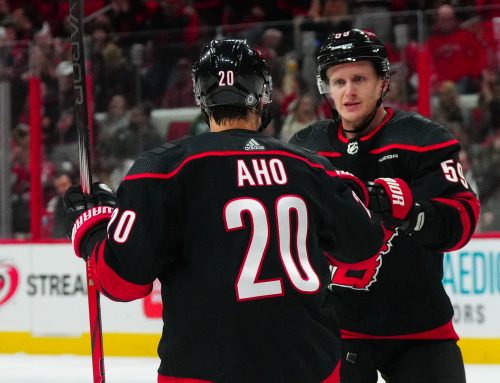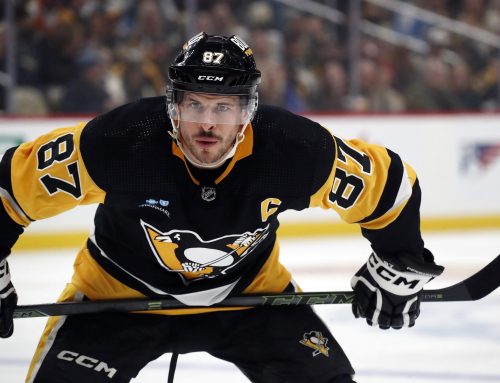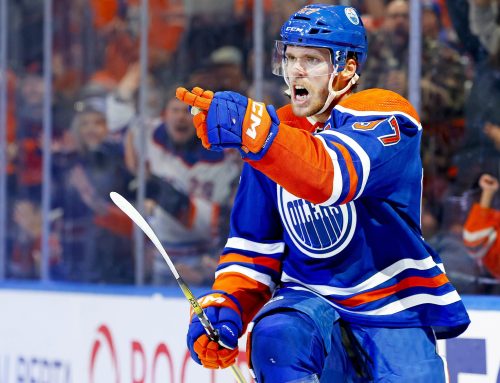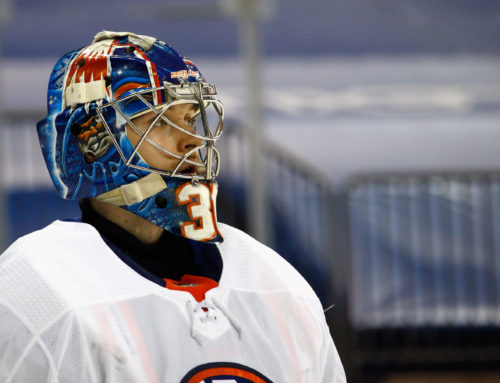Top 10 Poor PP Producers
Tom Collins
2021-04-19
One thing that can frustrate fantasy hockey general managers is when a player doesn't produce on the power play.
Most leagues count power-play points as a category. Even in a points-only league, having success with the man advantage can mean the difference between a 60-point player and a 40-point player. However, not all power-play points are created equal when dealing with fantasy and a player's value. Someone who averages four minutes of power-play time shouldn't be tied in power-play points with someone who averages two minutes per night.
With that in mind, we're going to look at a player's production, including power-play points per 60 minutes (referred to as PPP/60) of players that average 1:30 of power-play time per game.
You may notice a few absent players. Going into Sunday's action, Sam Gagner is the only player that has played at least 20 games, averaged two minutes of power-play time and had zero power-play points. However, he's not fantasy-relevant so he won't be on the list. I also won't be including Thomas Chabot, the inspiration for this column from a couple of weeks ago when researching the top 10 players who are overhyped. His 2.86 PPP/60 is the fifth-lowest of all NHL defensemen averaging at least 2:15 per game (minimum 10 games), but four are worse: Christian Djoos, Ryan Suter, Rasmus Andersson and number five on this list.
10. Nikita Gusev
Even if Gusev can start getting points in Florida, you're probably better off staying away from him as he doesn't contribute in categories outside of shots. In 22 games between New Jersey and Florida, he has two hits, zero PIM, one blocked shot, no shorthanded stats, two power-play points and is a minus-13. Maybe he wasn't given a fair shake in New Jersey, but if he had value in other areas of his game (such as killing penalties or playing a physical game), he wouldn't have been a healthy scratch as often as he was. His two power-play points are a killer, considering that he has been on the ice on the ice for 54.4 per cent of power-play minutes this year. He's on the top unit in Florida and already has a power-play point, but his PPP/60 was 1.24 with New Jersey and 7.76 with Florida.
A few years back, I thought Arvidsson would have a chance to reach 70 points. At the time, I opined that Arvidsson needed to produce on the power-play to hit that mark. That never happened. His stats for the last five years:
2016-17: 2:00 ice time per night, nine PPP, 3.39 PPP/60
2017-18: 2:31 ice time per night, eight PPP, 2.45 PPP/60
2018-19: 2:55 ice time per night, four PPP, 1.42 PPP/60
2019-20: 2:28 ice time per night, eight PPP, 3.41 PPP/60
2020-21: 2:09 ice time per night, three PPP, 1.85 PPP/60
It's time for Nashville to admit defeat that Arvidsson will never be a power-play producer and give his spot to someone else.
No Hab player suffered more than Drouin when Montreal decided to switch to two even power-play units a couple of years ago. From 2016-17 to 2018-19, Drouin averaged 21 power-play points a season (one of those years was with Tampa Bay). That was when he was on the ice for about 60 per cent of the team's PP minutes. Last year, he had four points in 27 games, which equals about 12 in an 82-game season. This year, he has five PPP in 42 games, about 10 in a normal year. Of course, he's averaging less than 50 per cent of the team's power-play minutes in the last two campaigns. He's also becoming less proficient, seeing his PPP/60 drop every season from 6.93 in 2016-17 to 3.09 this year.
It's amazing how jerky this guy's power-play production is. He goes from five to 20 with a snap of the fingers. This year, while losing only 24 seconds of power-play time from last year, he has only one power-play point. You would think that is because of a lack of quality linemates or a demotion to the second unit. However, last year, he was on the top unit with Ryan O'Reilly, David Perron and Brayden Schenn. This season, he also played on the top unit for a good chunk of the season and was only demoted in the past 10 games. Even though he missed some time due to injury, he hasn't scored a PPP in 21 games. His PPP/60 this year is 0.89. To get an idea of how bad that is, going into Sunday's action, 245 players have averaged at least 1:45 of power-play time per night (minimum of 10 games). Schwartz's PPP/60 ranks 240th. The only ones worse are Kirby Dach, Sam Gagner, two rookies in Barrett Hayton and Trevor Zegras, and number one on this list.
6. Matt Duchene
One of the biggest myths I've seen in fantasy hockey the past few years is that Duchene is a power-play specialist. Wherever he goes, you can read columns about how he will improve the power play of the team acquiring him. He's never reached 20 power-play points outside of his rookie season in 2009-10. For his career, he averages 14 power-play points per 82 games. This year, he has three PPP in 24 games and a PPP/60 minutes of 2.91. Duchene is a prime example of what should happen if you can't produce as he lost his spot on the top unit to Eeli Tolvanen before Duchene's injury cost him five weeks of the season. Tolvanen has 11 man-advantage points in 31 games this year, so his 82-game pace would easily best any of Duchene's 12 seasons.
There's probably a couple of players on Vegas who could have made this list, but Pietrangelo has been shockingly bad with the man advantage and had a PPP/60 of 1.56 heading into Sunday's game. While it may appear as if Shea Theodore is the top guy in Vegas, Theodore has only averaged an extra 20 seconds of power-play time per night. It's only since the start of April that Theodore has been getting more power-play time than Pietrangelo. Look at the breakdown of power-play time per game when AP wasn't missing injured:
Jan. 14 to Jan 26: 3:31 for Pietrangelo, 3:11 for Theodore
Feb. 11 to March 6: 2:30 for Pietrangelo, 2:30 for Theodore
March 31 to April 18: 2:16 for Pietrangelo, 2:37 for Theodore
Pietrangelo has the opportunity, but didn't produce with only two power-play points. That's a far fall from 22 PPP with the Blues a year ago.
4. Alex Killorn
Some may consider Killorn's power-play production a success. With six PPP in 44 games, he is on pace for 11 over an 82-game season, which would be the second-highest of his career and only two fewer than last year. However, he will never have this opportunity again. With Nikita Kucherov on the shelf, there was an opportunity to take advantage of the uptick in power-play time. He could have been like Bryan Rust last season. If he had dominated, the team would have found a way to keep him on the ice. Averaging more than three minutes a night with the man advantage, Killorn's production is disappointing. Killorn has a PPP/60 of 2.71, only trailing Tyler Johnson for the worst on the team.
Mantha might answer an important fantasy question: Is it better to have a player that is on the top unit of an awful power play or the second unit of a top-ranked power play? In 42 games with Detroit, Mantha had two power-play points while averaging 2:31 with the man advantage. In four games with Washington, he has two power-play points while averaging 2:06 per night. He's never been a big producer with the man advantage (a career-high 13 that he's hit twice), but he could top that next season. His PPP/60 was 1.13 with Detroit and 14.26 with Washington.
Sure, his overall production is down as he's only played 26 games, but he's taken a step back this season. Many were hoping he would finally eclipse the point-per-game mark, but instead he's dropped to 0.81 points-per-game (an 82-game pace of 66 points). After back-to-back seasons of at least 22 power-pay points, this year he's dropped down to five, despite averaging 4:24 a night with the man advantage, the fourth highest in the league. His PPP/60 has cratered from 5.19 and 5.46 in each of the previous two years to 2.62 this season.
Dadonov is the best example of a power-play specialist needing elite linemates to perform. After getting plenty of reps on the top unit in Florida, Ottawa signed Dadonov with the hopes that he could improve the Sens' power-play. In 45 games, he has only one power-play point while averaging 3:10 of power-play time per night. That's a PPP/60 minutes of 0.42. That means if Ottawa had a non-stop power-play for two-and-half games, Dadonov would score one point. If the team isn't doing well and a player isn't producing, why not replace him with a young player such as Colin White, who has four power-play points in 35 games while averaging 1:32 of power-play TOI per night. Switching out an underperforming veteran with productive younger player worked for Nashville.





 NYR
NYR WSH
WSH FLA
FLA T.B
T.B WPG
WPG COL
COL VAN
VAN NSH
NSH EDM
EDM TOR
TOR CAR
CAR BOS
BOS VGK
VGK
